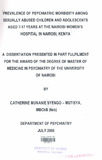| dc.contributor.author | Syengo, Catherine M M | |
| dc.date.accessioned | 2013-05-27T11:35:11Z | |
| dc.date.available | 2013-05-27T11:35:11Z | |
| dc.date.issued | 2006 | |
| dc.identifier.citation | M.Med (Psychiatry) Thesis | en |
| dc.identifier.uri | http://erepository.uonbi.ac.ke:8080/xmlui/handle/123456789/26193 | |
| dc.description | Master of Medicine | en |
| dc.description.abstract | Introduction: For the last three years, the number of sexually abused children and adolescents
reportingto the Nairobi Women's Hospital (NWH) has been increasing. Despite the fact that these
childrenand adolescents have experienced trauma, no studies have been done to assess the
psychiatricmorbidity among such survivors in the hospital and in the entire country.
Objectives: 1.To describe the social demographic profile of the sexually abused children and
adolescents aged 7 - 17 yrs attending NWH
2. To determine psychiatric morbidity among these persons.
3. To determine if there is any relationship between the PM and the sexual abuse variables used in
the study.
4. To make any necessary recommendations on prevention of childhood sexual abuse and
treatment of those abused.
Design: Cross-sectional descriptive survey using consecutive sampling.
Setting: The study was carried out at the Nairobi Women's Hospital GVRC.
Method: A consecutive sample of 61 survivors meeting the inclusion criteria was interviewed using
a structured social demographic questionnaire and a sexual assault profile questionnaire. The
sample was also subjected to a DSM IV-TR manual guided psychiatric evaluation. Data was
analyzed using SPSS version 12.
Results: Out of the 61 subjects studied, the male to female ratio was 1:9; the age range was 7-17
yearswith75% of the sample being in the age group of 7-12 years (children) and 25% being in the
agegroupof 13 - 17 years (adolescents). The mean age was 11.1 years; the standard deviation
was3.3 while the age mode was 7 years and the median age 11 years. The prevalence of
psychiatricmorbidity among the subjects studied as measured by the DSM IV- TR was found to be
69%.The following DSM IV-TR diagnoses were found: depressive disorder not otherwise specified
NOS(41%), acute stress disorder (23%), post traumatic stress disorder (22%), dysthymic disorder
(5%),oppositional deviant disorder (3%), attention deficit hyperactivity disorder (2%), conduct
disorder (2%) and bipolar 1 disorder (2%). Suicidal ideation was found to be present in 3% of the
cases. Factors like whether a subject knew own parents, whether parents were alive, parental
marital status, whether subject had a step parent, whether subject attended school, who brought
up the subject, social economic status and how family sorted out disagreements were used to
measure family stability. Results showed that 62% of subjects' parents/caregivers were unskilled
laborers whereas none of the abused subjects' parents were professionals. Sixty nine percent of
the subjects' families had no history of mental illness but 66% of the parents used substances of
abuse. A large portion of the survivors (67%) had less than 3 siblings. On the socio demographic
profile, the only factor that showed a statistically significant relationship with psychiatric morbidity
was the family's way of sorting out their disagreements (p= 0.045). Majorities (82%) of the subjects
were abused by a non stranger (neighbor, caregiver or a parent) and only 18% were abused by
strangers. Most (90%) of the abused survivors were subjected to vaginal or anal penetration. More
than half (64%) of the survivors were abused for extremely short periods e.g. a day while 36%
were abused for longer periods. More than half (66%) of the abuse was discovered within 48 hrs
after the last abuse, while 34% was discovered later. Majority (93%) sustained physical injuries
ranging from mild to severe as a result of the abuse. Less than half (46%) made efforts to resist the | en |
| dc.description.sponsorship | University of Nairobi | en |
| dc.language.iso | en | en |
| dc.title | Prevalence of psychiatric morbidity among sexually abused children and adolescents aged 7-17 years at the Nairobi Women's Hospital in Nairobi, Kenya | en |
| dc.type | Thesis | en |
| dc.description.department | a
Department of Psychiatry, University of Nairobi, ; bDepartment of Mental Health, School of Medicine,
Moi University, Eldoret, Kenya | |
| local.publisher | Department of Psychiatry, University of Nairobi | en |

